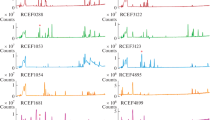Abstract
Objective
To study the β-glucosidase gene (bgy1) from Lactobacillus brevis that was cloned and expressed in Escherichia coli BL21 (DE3) and then using it for the biotransformation of gypenoside XVII.
Results
The bgy1 gene consists of 2283 bp encoding 761 amino acids, with homology to the glycosyl hydrolase family-3 protein domain. The enzyme (Bgy1) hydrolyzed the glucose moieties at the C-3 position and the outer glucose moieties at the C-20 position of gypenoside XVII. Using 0.1 mg enzyme ml−1 in 20 mM sodium phosphate buffer at 30 °C and pH 6.0, 1 mg gypenoside XVII ml−1 was transformed into 0.58 mg compound K ml−1 within 6 h, with a corresponding molar conversion yield of 89 %.
Conclusion
The recombinant Bgy1 is considered potentially useful for the practical preparation of compound K.




Similar content being viewed by others
References
Bae EA, Choo MK, Park EK, Park SY, Shin HY, Kim DH (2002) Metabolism of ginsenoside Rc by human intestinal bacteria and its related antiallergic activity. Biol Pharm Bull 25:743–747
Bae EA, Han MJ, Kim EJ, Kim DH (2004) Transformation of ginseng saponins to ginsenoside Rh2 by acids and human intestinal bacteria and biological activities of their transformants. Arch Pharm Res 27:61–67
Cheng LQ, Na JR, Kim MK, Bang MH, Yang DC (2007) Microbial conversion of ginsenoside Rb1 to minor ginsenoside F2 and gypenoside XVII by Intrasporangium sp. GS603 isolated from soil. J Microbiol Biotechnol 17:1937–1943
Cho W, Chung W, Lee S, Leung A, Cheng C, Yue K (2006) Ginsenoside Re of Panax ginseng possesses significant antioxidant and anti-hyperlipidemic efficacies in streptozotocin-induced diabetic rats. Eur J Pharmacol 550:173–179
Cui CH, Kim SC, Im WT (2013) Characterization of the ginsenoside-transforming recombinant β-glucosidase from Actinosynnema mirum and bioconversion of major ginsenosides into minor ginsenosides. Appl Microbiol Biotechnol 97:649–659
Kim WY, Kim JM, Han SB, Lee SK, Kim ND, Park MK, Kim CK, Park JH (2000) Steaming of ginseng at high temperature enhances biological activity. J Nat Prod 63:1702–1704
Kim EM, Seo JH, Kim J, Park JS, Kim DH, Kim BG (2013) Production of ginsenoside aglycons and Rb1 deglycosylation pathway profiling by HPLC and ESI-MS/MS using Sphingobacterium multivorum GIN723. Appl Environ Microbiol 97:8031–8039
Lee J, Lee E, Kim D, Yoo J, Koh B (2009) Studies on absorption, distribution and metabolism of ginseng in humans after oral administration. J Ethnopharmacol 122:143–148
Noh KH, Son JW, Kim HJ, Oh DK (2009) Ginsenoside compound K production from ginseng root extract by a thermostable beta-glycosidase from Sulfolobus solfataricus. Biosci Biotechnol Biochem 73:316–321
Quan LH, Liang Z, Kim HB, Kim SH, Kim SY, Noh YD, Yang DC (2008) Conversion of ginsenoside Rd to compound K by crude enzymes extracted from Lactobacillus brevis LH8. J Ginseng Res 32:226–231
Quan LH, Min JW, Jin Y, Wang C, Kim YJ, Yang DC (2012a) Enzymatic biotransformation of ginsenoside Rb1 to compound K by recombinant β-glucosidase from Microbacterium esteraromaticum. J Agric Food Chem 60:3776–3781
Quan LH, Min JW, Sathiyamoorthy S, Yang DU, Kim YJ, Yang DC (2012b) Biotransformation of ginsenosides Re and Rg1 into ginsenosides Rg2 and Rh1 by recombinant β-glucosidase. Biotechnol Lett 34:913–917
Quan LH, Min JW, Yang DU, Kim YJ, Yang DC (2012c) Enzymatic biotransformation of ginsenoside Rb1 to 20(S)-Rg3 by recombinant β-glucosidase from Microbacterium esteraromaticum. Appl Microbiol Biotechnol 94:377–384
Tawab MA, Bahr U, Karas M, Wurglics M, Schubert-Zsilavecz M (2003) Degradation of ginsenosides in humans after oral administration. Drug Metab Dispos 31:1065–1071
Wakabayashi C, Hasegawa H, Murata J, Saiki I (1997) In vivo antimetastatic action of ginseng protopanaxadiol saponins is based on their intestinal bacterial metabolites after oral administration. Oncol Res 9:411–417
Wan JY, Liu P, Wang HY, Qi LW, Wang CZ, Li P, Yuan CS (2013) Biotransformation and metabolic profile of American ginseng saponins with human intestinal microflora by liquid chromatography quadrupole time-of-flight mass spectrometry. J Chromatogr A 1286:83–92
Acknowledgments
This study was supported by a China Postdoctoral Science Foundation funded Project (No. 2015M571376).
Supporting Information
Supplementary Fig. 1—Compound K production from gypenoside XVII by Bgy1 under the optimum conditions.
Author information
Authors and Affiliations
Corresponding authors
Electronic supplementary material
Below is the link to the electronic supplementary material.
Rights and permissions
About this article
Cite this article
Zhong, FL., Dong, WW., Wu, S. et al. Biotransformation of gypenoside XVII to compound K by a recombinant β-glucosidase. Biotechnol Lett 38, 1187–1193 (2016). https://doi.org/10.1007/s10529-016-2094-3
Received:
Accepted:
Published:
Issue Date:
DOI: https://doi.org/10.1007/s10529-016-2094-3




